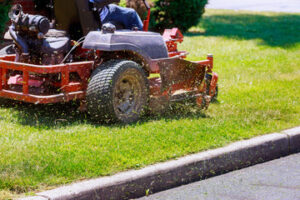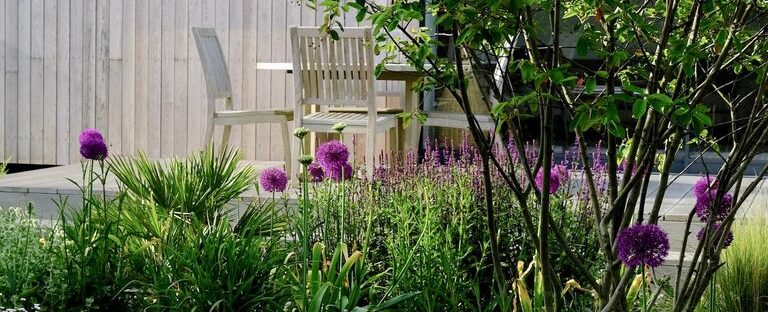A well-manicured lawn does more than improve the look of your property, it also benefits the environment. Mow correctly, water deeply, fertilize appropriately and weed control regularly.

Water deeply and infrequently rather than lightly each day. This encourages deep root growth making your lawn more drought tolerant. Visit https://www.primecutlawnky.com/ to learn more.
A soil test will tell you whether your lawn needs more nitrogen, iron or other nutrients. Use a fertilizer that is low in phosphorus and potassium.
Lawns need a steady supply of nutrients to stay thick and healthy. The right lawn fertilization schedule influences grass color and ability to recover from stress, and helps it resist weed invasions and disease. You can purchase lawn fertilizers at your local garden center, but professional fertilization services provide the best results. They know how to read soil conditions and use a precise application method that makes sure your lawn gets the right nutrients to grow lush.
The right time to fertilize depends on your climate and your grass type. In general, cool-season lawns should be fertilized in the fall and warm-season lawns should be fertilized in spring. Grass that’s fertilized at the wrong times can weaken it and leave it vulnerable to diseases, weeds and drought.
Most fertilizers contain a mix of different nutrients, with most having nitrogen, phosphorus and potassium (N-P-K). Nitrogen is the nutrient that gives lawns their green glow, while phosphorus promotes growth and encourages dense grass shoots. Potassium strengthens cell walls, making the lawn more resistant to drought and fungal infections.
In addition to the N-P-K fertilizer mix, many commercial lawn care services include micronutrients and bio-stimulants that enhance color and promote growth. Some services also offer aeration, which creates small holes in the lawn to allow water, air and nutrients to circulate more easily.
When choosing lawn fertilizers, look for organic or slow-release options. The former are natural and do not contain synthetic chemicals, while the latter may require action by soil microbes before the nutrients become available to grass plants. Organic fertilizers often cost more than their synthetic counterparts, but they do not linger in the environment like synthetic pesticides.
Aerate
Aerating lawns is one of the most important things a landscaper can do to help your grass thrive. The purpose of aerating is to relieve soil compaction by puncturing the ground with small holes. This allows air, water and nutrients to penetrate the roots more easily. The aeration process also helps reduce thatch build-up.
Getting your yard professionally aerated can be done with a machine that pokes holes into the turf to remove small “plugs” of dirt, or using hollow tines on a rake. Depending on the type of lawn you have, different soils may require aeration more often than others. For example, clay soils tend to compact very easily, so they need to be aerated more frequently than sandy or loamy soils.
Other services offered by lawn care companies include weed control, mulching, and deep root feeding for trees and shrubs. Weed control is typically a liquid spray or granular product that targets the specific weed species growing in your lawn.
Lawn mowing is also part of the lawn care process. Getting your yard mowed correctly, at the right time and at the proper height is essential to healthy grass. A landscaper will have the appropriate mowers and weed whackers for your yard and know how to mow properly for the best results.
Mow
A well-manicured lawn is the visual representative of a home or business’s status. It can even be a factor in real estate sales. Lawn care services are a great way to keep your property looking beautiful and healthy. They often include mowing, fertilization, aeration, weed control and pruning. They may also offer organic pesticides and lawn care treatments that are better for the environment and safer for kids and pets.
When looking for a lawn care service, consider the length of time they’ve been in business and their reputation. Ask for references and check online reviews. A company with a solid track record will have a good chance of providing quality work.
It’s also important to consider the mowing method they use. Many companies will bag or mulch the clippings depending on the season and client preference. Many landscapers will also sharpen mower blades a few times a year to ensure a clean cut that promotes upright shoot growth. They’ll also vary mowing patterns to avoid scalping. They might push the mower north and south one week and east and west the next.
In addition to mowing, lawn maintenance may also include aeration, dethatching and preventative fungicide treatments. These services can improve soil health, which is necessary for a healthy lawn. They can also correct pH imbalances in the soil and prevent depletion of nutrients.
While it’s possible for people to do the basic lawn care themselves, hiring a professional will make the process much more manageable and less time-consuming. Trying to do everything at once can be a recipe for disaster. It’s best to hire a lawn care company that specializes in improving soil health, as this is the foundation for a healthy yard.
Weed
Weeds are a common problem for homeowners. They compete with grass for resources such as water and micronutrients. Consequently, the grass struggles to grow properly. This is why weeding lawns should be a priority for those who want healthy gardens.
Weeds also provide shelter for pests that are harmful to the plants and grass in a garden. If they’re located near a home, these unwelcome pests can easily enter the house, causing more problems. This is why weeds should be removed regularly to avoid the risk of infestation.
Despite their negative effects, weeds play an important role in soil health. They break up hard-packed layers of soil, allowing air and water to penetrate more easily. They also help bring degraded soils back to life by feeding microorganisms that release nutrients into the ground.
However, if not controlled, weeds can become overwhelming and take away from the beauty of a well-manicured garden. They can also block the sunlight needed for grass and other desirable plants to prepare food through photosynthesis.
For these reasons, it’s important to monitor the weeds in your yard for signs of growth. Early spring is the best time to do this since it’s when a pre-emergent spray can be applied to prevent weeds from growing. A lawn care professional will consider the weather, moisture levels and other plants in your yard when selecting the right herbicide for your property.
Alternatively, some people choose to simply kill all the weeds with a herbicide after they sprout. While this may work, it’s usually overkill and exposes the soil to unnecessary damage. It’s much better to monitor weeds, identify the types and their locations and use low-toxicity herbicides as needed.
Trim
A healthy lawn adds curb appeal to a home and provides a space for outdoor activities. It can also increase property value. However, a beautiful lawn requires regular maintenance to thrive. This includes mowing, fertilization, aerating, weeding, trimming, and pest control. Without these services, a lawn can become vulnerable to disease, starvation, and pest infestation. Fixing these issues can be costly and take a lot of time. Regular mowing and trimming prevents these problems from occurring in the first place.
When mowing, it is important to choose the right height for your lawn. Too short grass can result in weak growth, while too tall grass can encourage weeds to grow and block sunlight from reaching the grass roots. The ideal grass length will vary based on the season and local climate.
Regular mowing will help keep your lawn looking its best and will allow for a smoother transition between different seasons. It can also be a great way to get rid of unwanted weeds, but it’s important to pull weeds by the root rather than just spraying them with herbicide.
Grass can deplete soil nutrients, so it’s crucial to regularly feed your lawn. Fertilizing in the fall and spring will promote thicker grass and help with weed control. It’s important to do a soil test each year to find out how much of each nutrient your yard needs.
Timing is important for many lawn treatments, including mowing, watering, and aerating. Watering in the morning is best because it gives the grass time to absorb moisture before the sun heats up the soil. This can reduce the risk of diseases that can develop due to prolonged wetness. Avoid watering at night, as this can encourage fungus and molds to grow.


